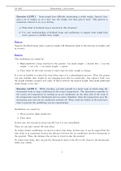Exam (elaborations)
Homework 2 Solutions - University of California, Los Angeles LIFESCIENC 30B
- Course
- Institution
Homework 2 Solutions Exercise 4.2.FE 1 Some people have difficulty maintaining a stable weight. Instead, they gain a lot of weight, go on a diet, lose the weight, but then gain it back. This pattern is sometimes referred to as yo-yo dieting. a) What kind of feedback loop is involved in this sit...
[Show more]



